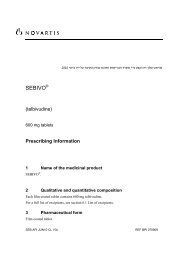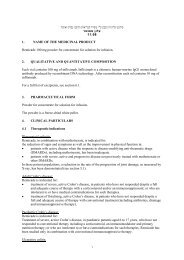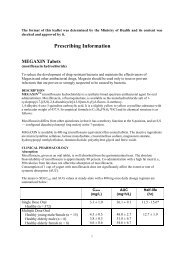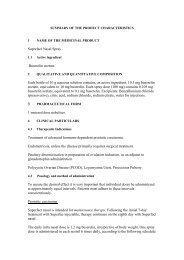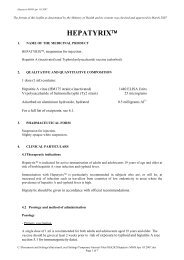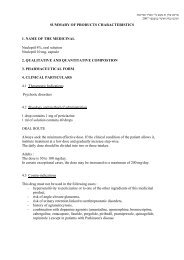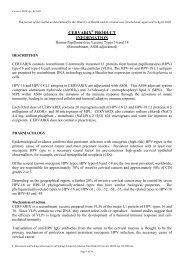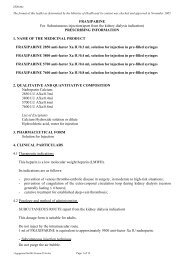galvus
galvus
galvus
Create successful ePaper yourself
Turn your PDF publications into a flip-book with our unique Google optimized e-Paper software.
GALVUS ®<br />
(vildagliptin)<br />
50 mg Tablets<br />
Prescribing Information<br />
. 2009 רבמבונב ודי לע רשואו קדבנ ונכותו תואירבה דרשמ י"<br />
ע עבקנ הז ןולע טמרופ<br />
1. NAME OF THE MEDICINAL PRODUCT<br />
Galvus 50 mg tablets<br />
2. QUALITATIVE AND QUANTITATIVE COMPOSITION<br />
Each tablet contains 50 mg of vildagliptin.<br />
Excipient: Each tablet contains 47.82 mg anhydrous lactose.<br />
For a full list of excipients, see section 6.1.<br />
3. PHARMACEUTICAL FORM<br />
Tablet<br />
White to light yellowish, round (8 mm diameter), flat-faced, bevelled-edge tablet. One side is<br />
debossed with “NVR”, and the other side with “FB”.<br />
4. CLINICAL PARTICULARS<br />
4.1 Therapeutic indications<br />
Vildagliptin is indicated in the treatment of type 2 diabetes mellitus:<br />
As dual oral therapy in combination with<br />
- metformin, in patients with insufficient glycaemic control despite maximal tolerated dose of<br />
monotherapy with metformin,<br />
- a sulphonylurea, in patients with insufficient glycaemic control despite maximal tolerated dose<br />
of a sulphonylurea and for whom metformin is inappropriate due to contraindications or<br />
intolerance,<br />
- a thiazolidinedione, in patients with insufficient glycaemic control and for whom the use of a<br />
thiazolidinedione is appropriate.<br />
4.2 Posology and method of administration<br />
Adults<br />
GAL API NOV09 CL V2c 1 REF: BPI 120309
When used in dual combination with metformin or a thiazolidinedione, the recommended daily dose<br />
of vildagliptin is 100 mg, administered as one dose of 50 mg in the morning and one dose of 50 mg in<br />
the evening.<br />
When used in dual combination with a sulphonylurea, the recommended dose of vildagliptin is 50 mg<br />
once daily administered in the morning. In this patient population, vildagliptin 100 mg daily was no<br />
more effective than vildagliptin 50 mg once daily.<br />
Doses higher than 100 mg are not recommended.<br />
The safety and efficacy of vildagliptin as triple oral therapy in combination with metformin and a<br />
thiazolidinedione or with metformin and a sulphonylurea has not been established.<br />
Galvus can be administered with or without a meal (see also section 5.2).<br />
Additional information on special populations<br />
Renal impairment<br />
No dose adjustment is required in patients with mild renal impairment (creatinine clearance<br />
≥ 50 ml/min). The use of Galvus is not recommended in patients with moderate or severe renal<br />
impairment or in haemodialysis patients with end-stage renal disease (ESRD) (see also sections 4.4<br />
and 5.2).<br />
Hepatic impairment<br />
Galvus should not be used in patients with hepatic impairment, including patients with pre-treatment<br />
alanine aminotransferase (ALT) or aspartate aminotransferase (AST) > 3x the upper limit of normal<br />
(ULN) (see also sections 4.4 and 5.2).<br />
Elderly (≥ 65 years)<br />
No dose adjustments are necessary in elderly patients. Experience in patients aged 75 years and older<br />
is limited and caution should be exercised when treating this population (see also sections 5.1 and 5.2).<br />
Paediatric population (< 18 years)<br />
Galvus is not recommended for use in children and adolescents due to a lack of data on safety and<br />
efficacy.<br />
4.3 Contraindications<br />
Hypersensitivity to the active substance or to any of the excipients.<br />
4.4 Special warnings and precautions for use<br />
General<br />
Galvus is not a substitute for insulin in insulin-requiring patients. Galvus should not be used in<br />
patients with type 1 diabetes or for the treatment of diabetic ketoacidosis.<br />
Renal impairment<br />
There is limited experience in patients with moderate to severe renal impairment or in patients with<br />
ESRD on haemodialysis. Therefore, the use of Galvus is not recommended in these patients.<br />
Hepatic impairment<br />
Galvus should not be used in patients with hepatic impairment, including patients with pre-treatment<br />
ALT or AST > 3x ULN.<br />
Liver enzyme monitoring<br />
Rare cases of hepatic dysfunction (including hepatitis) have been reported. In these cases, the patients<br />
were generally asymptomatic without clinical sequelae and liver function test results returned to<br />
normal after discontinuation of treatment. Liver function tests should be performed prior to the<br />
GAL API NOV09 CL V2c 2 REF: BPI 120309
initiation of treatment with Galvus in order to know the patient’s baseline value. Liver function should<br />
be monitored during treatment with Galvus at three-month intervals during the first year and<br />
periodically thereafter. Patients who develop increased transaminase levels should be monitored with a<br />
second liver function evaluation to confirm the finding and be followed thereafter with frequent liver<br />
function tests until the abnormality(ies) return(s) to normal. Should an increase in AST or ALT of 3x<br />
ULN or greater persist, withdrawal of Galvus therapy is recommended.<br />
Patients who develop jaundice or other signs suggestive of liver dysfunction should discontinue<br />
Galvus.<br />
Following withdrawal of treatment with Galvus and LFT normalisation, treatment with Galvus should<br />
not be reinitiated.<br />
Cardiac failure<br />
Experience with vildagliptin therapy in patients with congestive heart failure of New York Heart<br />
Association (NYHA) functional class I-II is limited and therefore vildagliptin should be used<br />
cautiously in these patients. There is no experience of vildagliptin use in clinical trials in patients with<br />
NYHA functional class III-IV and therefore use is not recommended in these patients.<br />
Skin disorders<br />
Skin lesions, including blistering and ulceration have been reported in extremities of monkeys in nonclinical<br />
toxicology studies (see section 5.3). Although skin lesions were not observed at an increased<br />
incidence in clinical trials, there was limited experience in patients with diabetic skin complications.<br />
Therefore, in keeping with routine care of the diabetic patient, monitoring for skin disorders, such as<br />
blistering or ulceration, is recommended.<br />
Excipients<br />
The tablets contain lactose. Patients with rare hereditary problems of galactose intolerance, the Lapp<br />
lactase deficiency or glucose-galactose malabsorption should not take this medicinal product.<br />
4.5 Interaction with other medicinal products and other forms of interaction<br />
Vildagliptin has a low potential for interactions with co-administered medicinal products. Since<br />
vildagliptin is not a cytochrome P (CYP) 450 enzyme substrate and does not inhibit or induce CYP<br />
450 enzymes, it is not likely to interact with active substances that are substrates, inhibitors or inducers<br />
of these enzymes.<br />
Combination with pioglitazone, metformin and glibenclamide<br />
Results from studies conducted with these oral antidiabetics have shown no clinically relevant<br />
pharmacokinetic interactions.<br />
Digoxin (Pgp substrate), warfarin (CYP2C9 substrate)<br />
Clinical studies performed with healthy subjects have shown no clinically relevant pharmacokinetic<br />
interactions. However, this has not been established in the target population.<br />
Combination with amlodipine, ramipril, valsartan or simvastatin<br />
Drug-drug interaction studies in healthy subjects were conducted with amlodipine, ramipril, valsartan<br />
and simvastatin. In these studies, no clinically relevant pharmacokinetic interactions were observed<br />
after co-administration with vildagliptin.<br />
As with other oral antidiabetic medicinal products the hypoglycaemic effect of vildagliptin may be<br />
reduced by certain active substances, including thiazides, corticosteroids, thyroid products and<br />
sympathomimetics.<br />
4.6 Pregnancy and lactation<br />
GAL API NOV09 CL V2c 3 REF: BPI 120309
There are no adequate data from the use of vildagliptin in pregnant women. Studies in animals have<br />
shown reproductive toxicity at high doses (see section 5.3). The potential risk for humans is unknown.<br />
Due to lack of human data, Galvus should not be used during pregnancy.<br />
It is not known whether vildagliptin is excreted in human breast milk. Animal studies have shown<br />
excretion of vildagliptin in milk. Galvus should not be used during lactation.<br />
4.7 Effects on ability to drive and use machines<br />
No studies on the effects on the ability to drive and use machines have been performed. Patients who<br />
experience dizziness as an undesirable effect should avoid driving vehicles or using machines.<br />
4.8 Undesirable effects<br />
Safety data were obtained from a total of 3,784 patients exposed to vildagliptin at a daily dose of<br />
50 mg (once daily) or 100 mg (50 mg twice daily or 100 mg once daily) in controlled trials of at least<br />
12 weeks duration. Of these patients, 2,264 patients received vildagliptin as monotherapy and<br />
1,520 patients received vildagliptin in combination with another medicinal product. 2,682 patients<br />
were treated with vildagliptin 100 mg daily (2,027 with 50 mg twice daily and 655 with 100 mg once<br />
daily) and 1,102 patients were treated with vildagliptin 50 mg once daily.<br />
The majority of adverse reactions in these trials were mild and transient, not requiring treatment<br />
discontinuations. No association was found between adverse reactions and age, ethnicity, duration of<br />
exposure or daily dose.<br />
Rare cases of hepatic dysfunction (including hepatitis) have been reported. In these cases, the patients<br />
were generally asymptomatic without clinical sequelae and liver function returned to normal after<br />
discontinuation of treatment. In data from controlled monotherapy and add-on therapy trials of up to<br />
24 weeks in duration, the incidence of ALT or AST elevations ≥ 3x ULN (classified as present on at<br />
least 2 consecutive measurements or at the final on-treatment visit) was 0.2%, 0.3% and 0.2% for<br />
vildagliptin 50 mg once daily, vildagliptin 50 mg twice daily and all comparators, respectively. These<br />
elevations in transaminases were generally asymptomatic, non-progressive in nature and not<br />
associated with cholestasis or jaundice.<br />
Rare cases of angioedema have been reported on vildagliptin at a similar rate to controls. A greater<br />
proportion of cases were reported when vildagliptin was administered in combination with an<br />
angiotensin converting enzyme inhibitor (ACE-Inhibitor). The majority of events were mild in<br />
severity and resolved with ongoing vildagliptin treatment.<br />
Adverse reactions reported in patients who received Galvus in double-blind studies as monotherapy<br />
and add-on therapies are listed below for each indication by system organ class and absolute<br />
frequency. Frequencies are defined as very common (≥1/10), common (≥1/100,
Table 1 Adverse reactions reported in patients who received Galvus 100 mg daily in<br />
combination with metformin in double-blind studies (N=208)<br />
Nervous system disorders<br />
Common Tremor<br />
Common Headache<br />
Common Dizziness<br />
Uncommon Fatigue<br />
Gastrointestinal disorders<br />
Common Nausea<br />
Metabolism and nutrition disorders<br />
Common Hypoglycaemia<br />
Long term clinical trials of up to more than 2 years did not show any additional safety signal or<br />
unforseen risks when vildagliptin was added on to metformin.<br />
Combination with a sulphonylurea<br />
In controlled clinical trials with the combination of vildagliptin 50 mg + a sulphonylurea, the overall<br />
incidence of withdrawals due to adverse reactions was 0.6% in the vildagliptin 50 mg + sulphonylurea<br />
vs 0% in the placebo + sulphonylurea treatment group.<br />
In clinical trials, the incidence of hypoglycaemia when vildagliptin 50 mg once daily was added to<br />
glimepiride was 1.2% versus 0.6% for placebo + glimepiride. No severe hypoglycaemic events were<br />
reported in the vildagliptin arms.<br />
In clinical trials, weight did not change from baseline when vildagliptin 50 mg daily was added to<br />
glimepiride (-0.1 kg and -0.4 kg for vildagliptin and placebo, respectively).<br />
Table 2 Adverse reactions reported in patients who received Galvus 50 mg in combination<br />
with a sulphonylurea in double-blind studies (N=170)<br />
Infections and infestations<br />
Very rare Nasopharyngitis<br />
Nervous system disorders<br />
Common Tremor<br />
Common Headache<br />
Common Dizziness<br />
Common Asthenia<br />
Gastrointestinal disorders<br />
Uncommon Constipation<br />
Metabolism and nutrition disorders<br />
Common Hypoglycaemia<br />
Combination with a thiazolidinedione<br />
In controlled clinical trials with the combination of vildagliptin 100 mg daily+ a thiazolidinedione, no<br />
withdrawal due to adverse reactions was reported in either the vildagliptin 100 mg daily +<br />
thiazolidinedione or the placebo + thiazolidinedione treatment groups.<br />
In clinical trials, the incidence of hypoglycaemia was uncommon in patients receiving vildagliptin +<br />
pioglitazone (0.6%) but common in patients receiving placebo + pioglitazone (1.9%). No severe<br />
hypoglycaemic events were reported in the vildagliptin arms.<br />
In the pioglitazone add-on study, the absolute weight increases with placebo, Galvus 100 mg daily<br />
were 1.4 and 2.7 kg, respectively.<br />
GAL API NOV09 CL V2c 5 REF: BPI 120309
The incidence of peripheral oedema when vildagliptin 100 mg daily was added to a maximum dose of<br />
background pioglitazone (45 mg once daily) was 7.0%, compared to 2.5% for background<br />
pioglitazone alone.<br />
Table 3 Adverse reactions reported in patients who received Galvus 100 mg daily in<br />
combination with a thiazolidinedione in double-blind studies (N=158)<br />
Nervous system disorder<br />
Uncommon Headache<br />
Uncommon Asthenia<br />
Metabolism and nutrition disorders<br />
Common<br />
Weight increase<br />
Uncommon<br />
Hypoglycaemia<br />
Vascular disorders<br />
Common Oedema peripheral<br />
In addition, in controlled monotherapy trials with vildagliptin 100 mg daily, adverse reactions reported<br />
in patients treated with vildagliptin in excess of that in patients receiving placebo are dizziness,<br />
headache, oedema peripheral, constipation, nasopharyngitis, upper respiratory tract infection and<br />
arthralgia. In these trials, the overall incidence of withdrawals due to adverse reactions was no greater<br />
for patients treated with vildagliptin at doses of 100 mg daily (0.3%) than for placebo (0.6%) or<br />
comparators (0.5%).<br />
In comparative controlled monotherapy studies, hypoglycaemia was uncommon, reported in 0.4% (7<br />
of 1,855) of patients treated with vildagliptin 100 mg daily compared to 0.2% (2 of 1,082) of patients<br />
in the groups treated with an active comparator or placebo, with no serious or severe events reported.<br />
In clinical trials, weight did not change from baseline when vildagliptin 100 mg daily was<br />
administered as monotherapy (-0.3 kg and -1.3 kg for vildagliptin and placebo, respectively).<br />
Table 4 Adverse reactions reported in patients who received Galvus 100mg daily as<br />
monotherapy in double-blind studies (N=1,855)<br />
Nervous system disorder<br />
Common Dizziness<br />
Uncommon Headache<br />
Gastrointestinal disorders<br />
Uncommon Constipation<br />
Musculoskeletal and connective tissue disorders<br />
Uncommon Arthralgia<br />
Metabolism and nutrition disorders<br />
Uncommon Hypoglycaemia<br />
Infections and infestations<br />
Very rare Upper respiratory tract infection<br />
Very rare Nasopharyngitis<br />
Vascular disorders<br />
Uncommon Oedema peripheral<br />
GAL API NOV09 CL V2c 6 REF: BPI 120309
long term clinical trials of up to 2 years did not show any additional safety signals or unforeseen risks<br />
with vildagliptin monotherapy.<br />
Post-marketing Experience<br />
During post-marketing experience the following additional adverse drug reaction has been reported<br />
(frequency not known): urticaria.<br />
4.9 Overdose<br />
Information regarding overdose with vildagliptin is limited.<br />
Information on the likely symptoms of overdose was taken from a rising dose tolerability study in<br />
healthy subjects given Galvus for 10 days. At 400 mg, there were three cases of muscle pain, and<br />
individual cases of mild and transient paraesthesia, fever, oedema and a transient increase in lipase<br />
levels. At 600 mg, one subject experienced oedema of the feet and hands, and increases in creatine<br />
phosphokinase (CPK), aspartate aminotransferase (AST), C-reactive protein (CRP) and myoglobin<br />
levels. Three other subjects experienced oedema of the feet, with paraesthesia in two cases. All<br />
symptoms and laboratory abnormalities resolved without treatment after discontinuation of the study<br />
medicinal product.<br />
Management<br />
In the event of an overdose, supportive management is recommended. Vildagliptin cannot be removed<br />
by haemodialysis. However, the major hydrolysis metabolite (LAY 151) can be removed by<br />
haemodialysis.<br />
5. PHARMACOLOGICAL PROPERTIES<br />
5.1 Pharmacodynamic properties<br />
Pharmacotherapeutic group: Dipeptidyl peptidase 4 (DPP-4) inhibitors, ATC code: A10BH02<br />
Vildagliptin, a member of the islet enhancer class, is a potent and selective DPP-4 inhibitor.<br />
The administration of vildagliptin results in a rapid and complete inhibition of DPP-4 activity,<br />
resulting in increased fasting and postprandial endogenous levels of the incretin hormones GLP-1<br />
(glucagon-like peptide 1) and GIP (glucose-dependent insulinotropic polypeptide).<br />
By increasing the endogenous levels of these incretin hormones, vildagliptin enhances the sensitivity<br />
of beta cells to glucose, resulting in improved glucose-dependent insulin secretion. Treatment with<br />
vildagliptin 50-100 mg daily in patients with type 2 diabetes significantly improved markers of beta<br />
cell function including HOMA-β (Homeostasis Model Assessment–β), proinsulin to insulin ratio and<br />
measures of beta cell responsiveness from the frequently-sampled meal tolerance test. In non-diabetic<br />
(normal glycaemic) individuals, vildagliptin does not stimulate insulin secretion or reduce glucose<br />
levels.<br />
By increasing endogenous GLP-1 levels, vildagliptin also enhances the sensitivity of alpha cells to<br />
glucose, resulting in more glucose-appropriate glucagon secretion.<br />
The enhanced increase in the insulin/glucagon ratio during hyperglycaemia due to increased incretin<br />
hormone levels results in a decrease in fasting and postprandial hepatic glucose production, leading to<br />
reduced glycaemia.<br />
The known effect of increased GLP-1 levels delaying gastric emptying is not observed with<br />
vildagliptin treatment.<br />
GAL API NOV09 CL V2c 7 REF: BPI 120309
Clinical Experience<br />
More than 15,000 patients with type 2 diabetes participated in double-blind placebo- or activecontrolled<br />
clinical trials of up to more than 2 years treatment duration. In these studies, vildagliptin<br />
was administered to more than 9,000 patients at daily doses of 50 mg once daily, 50 mg twice daily or<br />
100 mg once daily. More than 5,000 male and more than 4,000 female patients received vildagliptin<br />
50 mg once daily or 100 mg daily. More than 1,900 patients receiving vildagliptin 50 mg once daily or<br />
100 mg daily were ≥ 65 years of age. In these trials, vildagliptin was administered as monotherapy in<br />
drug-naïve patients with type 2 diabetes or in combination in patients not adequately controlled by<br />
other antidiabetic medicinal products.<br />
Overall, vildagliptin improved glycaemic control when given as monotherapy or when used in<br />
combination with metformin, a sulphonylurea, and a thiazolidinedione, as measured by clinically<br />
relevant reductions in HbA1c from baseline at study endpoint (see Table 5).<br />
In clinical trials, the magnitude of HbA1c reductions with vildagliptin was greater in patients with<br />
higher baseline HbA1c.<br />
In a 52-week double-blind controlled trial, vildagliptin (50 mg twice daily) reduced baseline HbA1c by<br />
-1% compared to -1.6% for metformin (titrated to 2 g/day) statistical non-inferiority was not achieved.<br />
Patients treated with vildagliptin reported significantly lower incidences of gastrointestinal adverse<br />
reactions versus those treated with metformin.<br />
In a 24-week double-blind controlled trial, vildagliptin (50 mg twice daily) was compared to<br />
rosiglitazone (8 mg once daily). Mean reductions were -1.20% with vildagliptin and -1.48% with<br />
rosiglitazone in patients with mean baseline HbA1c of 8.7%. Patients receiving rosiglitazone<br />
experienced a mean increase in weight (+1.6 kg) while those receiving vildagliptin experienced no<br />
weight gain (-0.3 kg). The incidence of peripheral oedema was lower in the vildagliptin group than in<br />
the rosiglitazone group (2.1% vs. 4.1% respectively).<br />
In a 24 week trial, vildagliptin (50 mg twice daily) was compared to pioglitazone (30 mg once daily)<br />
in patients inadequately controlled with metformin. Mean reductions from baseline HbA1c of 8.4%<br />
were - 0.9% with vildagliptin added to metformin and -1.0% with pioglitazone added to metformin.<br />
The decrease in HbA1c from baseline >9.0% was greater (-1.5%) in both treatment groups. Patients<br />
receiving pioglitazone in addition to metformin experienced an increase in weight of 1.9 kg. Patients<br />
receiving vildagliptin in addition to metformin experienced an increase in weight of 0.3 kg . In a 28<br />
week extension, HbA1c reductions were similar between treatment groups and the body weight<br />
difference further increased.<br />
In a long-term trial of up to more than 2 years, vildagliptin (100 mg/day) was compared to glimepiride<br />
(up to 6 mg/day) in patients treated with metformin. After 1-year mean reductions in HbA1c were -<br />
0.4% with vildagliptin added to metformin and -0.5% with glimepiride added to metformin. Body<br />
weight change with vildagliptin was - 0.2 kg vs + 1.6 kg with glimepiride. The incidence of<br />
hypoglycemia was significantly lower in the vildagliptin group (1.7%) than in the glimepiride group<br />
(16.2%). At the study endpoint (2 years), the HbA1c was similar to baseline values in both treatment<br />
groups and the body weight changes and hypoglycemia differences were maintained.<br />
In a long-term trial of 2 years, vildagliptin (50 mg twice daily) was compared to gliclazide (up to 320<br />
mg/day). After two years, mean reduction in HbA1c was -0.5% for vildagliptin and 0.6% for<br />
gliclazide. Vildagliptin had less weight gain (0.75 kg) and fewer hypoglycemic events (0.7%) than<br />
gliclazide (1.6 kg and 1.7%, respectively).<br />
Table 5 Key efficacy results of vildagliptin in placebo-controlled monotherapy trials and in<br />
add-on combination therapy trials (primary efficacy ITT population)<br />
Monotherapy placebo<br />
Mean Mean change Placebo-<br />
controlled studies<br />
baseline from baseline in corrected mean<br />
HbA1c (%) HbA1c (%) at change in HbA1c<br />
week 24 (%) at week 24<br />
GAL API NOV09 CL V2c 8 REF: BPI 120309
Study 2301: Vildagliptin 50 mg<br />
twice daily (N=90)<br />
Study 2384: Vildagliptin 50 mg<br />
twice daily (N=79)<br />
Add-on / Combination studies<br />
Vildagliptin 50 mg twice daily +<br />
metformin (N=143)<br />
Vildagliptin 50 mg daily +<br />
glimepiride (N=132)<br />
Vildagliptin 50 mg twice daily +<br />
pioglitazone (N=136)<br />
5.2 Pharmacokinetic properties<br />
8.6 -0.8<br />
(95%CI)<br />
-0.5* (-0.8, -0.1)<br />
8.4 -0.7 -0.7* (-1.1, -0.4)<br />
* p< 0.05 for comparison versus<br />
placebo<br />
8.4 -0.9 -1.1* (-1.4, -0.8)<br />
8.5 -0.6 -0.6* (-0.9, -0.4)<br />
8.7 -1.0 -0.7* (-0.9, -0.4)<br />
* p< 0.05 for comparison versus<br />
placebo + comparator<br />
Absorption<br />
Following oral administration in the fasting state, vildagliptin is rapidly absorbed, with peak plasma<br />
concentrations observed at 1.7 hours. Food slightly delays the time to peak plasma concentration to<br />
2.5 hours, but does not alter the overall exposure (AUC). Administration of vildagliptin with food<br />
resulted in a decreased Cmax (19%). However, the magnitude of change is not clinically significant, so<br />
that Galvus can be given with or without food. The absolute bioavailability is 85%.<br />
Distribution<br />
The plasma protein binding of vildagliptin is low (9.3%) and vildagliptin distributes equally between<br />
plasma and red blood cells. The mean volume of distribution of vildagliptin at steady-state after<br />
intravenous administration (Vss) is 71 litres, suggesting extravascular distribution.<br />
Biotransformation<br />
Metabolism is the major elimination pathway for vildagliptin in humans, accounting for 69% of the<br />
dose. The major metabolite (LAY 151) is pharmacologically inactive and is the hydrolysis product of<br />
the cyano moiety, accounting for 57% of the dose, followed by the amide hydrolysis product (4% of<br />
dose). In vitro data in human kidney microsomes suggest that the kidney may be one of the major<br />
organs contributing to the hydrolysis of vildagliptin to its major inactive metabolite, LAY151. DPP-4<br />
contributes partially to the hydrolysis of vildagliptin based on an in vivo study using DPP-4 deficient<br />
rats. Vildagliptin is not metabolised by CYP 450 enzymes to any quantifiable extent. Accordingly, the<br />
metabolic clearance of vildagliptin is not anticipated to be affected by co-medications that are CYP<br />
450 inhibitors and/or inducers. In vitro studies demonstrated that vildagliptin does not inhibit/induce<br />
CYP 450 enzymes. Therefore, vildagliptin is not likely to affect metabolic clearance of co-medications<br />
metabolised by CYP 1A2, CYP 2C8, CYP 2C9, CYP 2C19, CYP 2D6, CYP 2E1 or CYP 3A4/5.<br />
Elimination<br />
Following oral administration of [ 14 C] vildagliptin, approximately 85% of the dose was excreted into<br />
the urine and 15% of the dose is recovered in the faeces. Renal excretion of the unchanged vildagliptin<br />
accounted for 23% of the dose after oral administration. After intravenous administration to healthy<br />
subjects, the total plasma and renal clearances of vildagliptin are 41 and 13 l/h, respectively. The mean<br />
elimination half-life after intravenous administration is approximately 2 hours. The elimination halflife<br />
after oral administration is approximately 3 hours.<br />
Linearity / non-linearity<br />
The Cmax for vildagliptin and the area under the plasma concentrations versus time curves (AUC)<br />
increased in an approximately dose proportional manner over the therapeutic dose range.<br />
Characteristics in patients<br />
GAL API NOV09 CL V2c 9 REF: BPI 120309
Gender<br />
No clinically relevant differences in the pharmacokinetics of vildagliptin were observed between male<br />
and female healthy subjects within a wide range of age and body mass index (BMI). DPP-4 inhibition<br />
by vildagliptin is not affected by gender.<br />
Age<br />
In healthy elderly subjects (≥ 70 years), the overall exposure of vildagliptin (100 mg once daily) was<br />
increased by 32%, with an 18% increase in peak plasma concentration as compared to young healthy<br />
subjects (18-40 years). These changes are, however, not considered to be clinically relevant. DPP-4<br />
inhibition by vildagliptin is not affected by age.<br />
Hepatic impairment<br />
The effect of impaired hepatic function on the pharmacokinetics of vildagliptin was studied in patients<br />
with mild, moderate and severe hepatic impairment based on the Child-Pugh scores (ranging from 6<br />
for mild to 12 for severe) in comparison with healthy subjects. The exposure to vildagliptin after a<br />
single dose in patients with mild and moderate hepatic impairment was decreased (20% and 8%,<br />
respectively), while the exposure to vildagliptin for patients with severe impairment was increased by<br />
22%. The maximum change (increase or decrease) in the exposure to vildagliptin is ~30%, which is<br />
not considered to be clinically relevant. There was no correlation between the severity of the hepatic<br />
disease and changes in the exposure to vildagliptin.<br />
Renal impairment<br />
In subjects with mild, moderate, or severe renal impairment, systemic exposure to vildagliptin was<br />
increased (Cmax 8-66%; AUC 32-134%) and total body clearance was reduced compared to subjects<br />
with normal renal function.<br />
Ethnic group<br />
Limited data suggest that race does not have any major influence on vildagliptin pharmacokinetics.<br />
5.3 Preclinical safety data<br />
Intra-cardiac impulse conduction delays were observed in dogs with a no-effect dose of 15 mg/kg (7fold<br />
human exposure based on Cmax).<br />
Accumulation of foamy alveolar macrophages in the lung was observed in rats and mice. The noeffect<br />
dose in rats was 25 mg/kg (5-fold human exposure based on AUC) and in mice 750 mg/kg (142fold<br />
human exposure).<br />
Gastrointestinal symptoms, particularly soft faeces, mucoid faeces, diarrhoea and, at higher doses,<br />
faecal blood were observed in dogs. A no-effect level was not established.<br />
Vildagliptin was not mutagenic in conventional in vitro and in vivo tests for genotoxicity.<br />
A fertility and early embryonic development study in rats revealed no evidence of impaired fertility,<br />
reproductive performance or early embryonic development due to vildagliptin. Embryo-foetal toxicity<br />
was evaluated in rats and rabbits. An increased incidence of wavy ribs was observed in rats in<br />
association with reduced maternal body weight parameters, with a no-effect dose of 75 mg/kg (10-fold<br />
human exposure). In rabbits, decreased foetal weight and skeletal variations indicative of<br />
developmental delays were noted only in the presence of severe maternal toxicity, with a no-effect<br />
dose of 50 mg/kg (9-fold human exposure). A pre- and postnatal development study was performed in<br />
rats. Findings were only observed in association with maternal toxicity at ≥ 150 mg/kg and included a<br />
transient decrease in body weight and reduced motor activity in the F1 generation.<br />
A two-year carcinogenicity study was conducted in rats at oral doses up to 900 mg/kg (approximately<br />
200 times human exposure at the maximum recommended dose). No increases in tumour incidence<br />
attributable to vildagliptin were observed. Another two-year carcinogenicity study was conducted in<br />
mice at oral doses up to 1,000 mg/kg. An increased incidence of mammary adenocarcinomas and<br />
GAL API NOV09 CL V2c 10 REF: BPI 120309
haemangiosarcomas was observed with a no-effect dose of 500 mg/kg (59-fold human exposure) and<br />
100 mg/kg (16-fold human exposure), respectively. The increased incidence of these tumours in mice<br />
is considered not to represent a significant risk to humans based on the lack of genotoxicity of<br />
vildagliptin and its principal metabolite, the occurrence of tumours only in one species and the high<br />
systemic exposure ratios at which tumours were observed.<br />
In a 13-week toxicology study in cynomolgus monkeys, skin lesions have been recorded at doses<br />
≥ 5 mg/kg/day. These were consistently located on the extremities (hands, feet, ears and tail). At<br />
5 mg/kg/day (approximately equivalent to human AUC exposure at the 100 mg dose), only blisters<br />
were observed. They were reversible despite continued treatment and were not associated with<br />
histopathological abnormalities. Flaking skin, peeling skin, scabs and tail sores with correlating<br />
histopathological changes were noted at doses ≥ 20 mg/kg/day (approximately 3 times human AUC<br />
exposure at the 100 mg dose). Necrotic lesions of the tail were observed at ≥ 80 mg/kg/day. Skin<br />
lesions were not reversible in the monkeys treated at 160 mg/kg/day during a 4-week recovery period.<br />
6. PHARMACEUTICAL PARTICULARS<br />
6.1 List of excipients<br />
Lactose, anhydrous<br />
Cellulose, microcrystalline<br />
Sodium starch glycolate (type A)<br />
Magnesium stearate<br />
6.2 Incompatibilities<br />
Not applicable.<br />
6.3 Special precautions for storage<br />
Store below 30 ○ C. Store in the original package in order to protect from moisture.<br />
6.4 Nature and contents of container<br />
Aluminium/Aluminium (PA/Al/PVC//Al) blister.<br />
6.6 Special precautions for disposal<br />
No special requirements.<br />
Manufacturer:<br />
Novartis Pharma Stein AG, Switzerland<br />
For Novartis Pharma AG, Basel, Switzerland<br />
Distributor:<br />
Novartis Pharma Services AG.<br />
36 Shacham St., Petach-Tikva.<br />
GAL API NOV09 CL V2c 11 REF: BPI 120309



